| dc.contributor.author | Lee, Michael A. | |
| dc.contributor.author | Jin, Xiaojia | |
| dc.contributor.author | Muthupalani, Sureshkumar | |
| dc.contributor.author | Bakh, Naveed A. | |
| dc.contributor.author | Gong, Xun | |
| dc.contributor.author | Strano, Michael S. | |
| dc.date.accessioned | 2023-05-04T20:03:25Z | |
| dc.date.available | 2023-05-04T20:03:25Z | |
| dc.date.issued | 2023-04-24 | |
| dc.identifier.uri | https://hdl.handle.net/1721.1/150599 | |
| dc.description.abstract | Abstract
Nanotechnology-enabled sensors or nanosensors are emerging as promising new tools for various in-vivo life science applications such as biosensing, components of delivery systems, and probes for spatial bioimaging. However, as with a wide range of synthetic biomaterials, tissue responses have been observed depending on cell types and various nanocomponent properties. The tissue response is critical for determining the acute and long term health of the organism and the functional lifetime of the material in-vivo. While nanomaterial properties can contribute significantly to the tissue response, it may be possible to circumvent adverse reactions by formulation of the encapsulation vehicle. In this study, five formulations of poly (ethylene glycol) diacrylate (PEGDA) hydrogel-encapsulated fluorescent nanosensors were implanted into SKH-1E mice, and the inflammatory responses were tracked in order to determine the favorable design rules for hydrogel encapsulation and minimization of such responses. Hydrogels with higher crosslinking density were found to allow faster resolution of acute inflammation. Five different immunocompromised mice lines were utilized for comparison across different inflammatory cell populations and responses. Degradation products of the gels were also characterized. Finally, the importance of the tissue response in determining functional lifetime was demonstrated by measuring the time-dependent nanosensor deactivation following implantation into animal models. | en_US |
| dc.publisher | BioMed Central | en_US |
| dc.relation.isversionof | https://doi.org/10.1186/s12951-023-01873-8 | en_US |
| dc.rights | Creative Commons Attribution | en_US |
| dc.rights.uri | http://creativecommons.org/licenses/by/4.0/ | en_US |
| dc.source | BioMed Central | en_US |
| dc.title | In-Vivo fluorescent nanosensor implants based on hydrogel-encapsulation: investigating the inflammation and the foreign-body response | en_US |
| dc.type | Article | en_US |
| dc.identifier.citation | Journal of Nanobiotechnology. 2023 Apr 24;21(1):133 | en_US |
| dc.contributor.department | Massachusetts Institute of Technology. Department of Chemical Engineering | |
| dc.contributor.department | Massachusetts Institute of Technology. Division of Comparative Medicine | |
| dc.identifier.mitlicense | PUBLISHER_CC | |
| dc.eprint.version | Final published version | en_US |
| dc.type.uri | http://purl.org/eprint/type/JournalArticle | en_US |
| eprint.status | http://purl.org/eprint/status/PeerReviewed | en_US |
| dc.date.updated | 2023-04-30T03:13:26Z | |
| dc.language.rfc3066 | en | |
| dc.rights.holder | The Author(s) | |
| dspace.date.submission | 2023-04-30T03:13:25Z | |
| mit.license | PUBLISHER_CC | |
| mit.metadata.status | Authority Work and Publication Information Needed | en_US |
